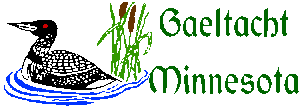
Quick Links
 |
Quick Links |
|
| GaelMinn Home | Dates: schedule, events | All Class | Tools | Amusements | ||
|
09/24/17 |
Gazette |
Last Issue | Sign Up | To Manage your Subscription |
The GaelMinn Gazette was a monthly e-newsletter from Gaeltacht Minnesota that carried news of interest to local and regional students, as well as helpful items for anyone who is studying the Irish language, anywhere.
Note: The final issue of this e-zine went out September 25, 2017
Issue #147 sent out September 25, 2017
Copyright © Gaeltacht Minnesota 2017
If you're old enough, you remember the song about poor Johnny one-note, who could only sing one note ("the note that he sings is AH . . . ."). Even if we aren't great singers, most of us would find singing just one note, one way, all the time a little odd.
But we see nothing about saying something in Irish only one way. One of the themes I often harp on is the value of translating English into Irish-- students spend way too much time going from Irish to English, and not enough time working in the other direction. But if you want to be able to produce Irish (spoken or written), you have to practice producing Irish.
That said, when students do translate things into Irish, they take each sentence and try to put it into the one perfect Irish utterance. Now, the original English sentence, the starting point that expresses some thought, is probably only one of a family of related sentences.
You wouldn't dream of having only one way to say something in English, so why be so narrow-minded about your Irish?
It doesn't matter what level you're at, you can add some variations that will give you a lot of practice producing Irish. Start by mixing together various English options, and then translating them.
Suppose your starting point is, "The box is on the table." Reverse it (table on box), modify the nouns (big box on little table, lots of adjective practice possible), put the box under the table, next to the table, use a possessive (my box on your table), and so on. Work through families of vocabulary. The box could be big, long, wide, heavy, or huge.
As you make progress with the language, you can add more complicated structures. "I see the box that is on the table." "It is the box that is on the table." You can change tense. The options are endless.
Because you are working with one central concept, you can develop a lot of variations quickly, meaning you'll get more Irish practice with less effort. And in the end, you'll have more ways to say what you want to say!
You cannot find a better weekend workshop than the one offered by the Celtic Cultural Center of Madison, WI, during the first full weekend of October. And there's still time to register!
Go to https://www.celticmadison.org/events/irish-weekend.html for registration forms and more information.
We're back in Central every Monday night through December 11.
Sharing ideas we learn from both instructors AND students.
Whether you're looking at a passage in a textbook, an article on a web site or in a newspaper, or listening to a radio or TV program in Irish, it is easy to get overwhelmed. You WANT to understand every word, but you only catch a few, and frustration sets in.
Part of the problem is unrealistic expectations. There's no reason you should quickly understand everything in another language, so focus on enjoying what you DO get, instead of feeling guilty because you don't get more of the meaning.
Then, bootstrap your way to understanding a little more by building on each scrap you recognize in your material. Here's how to do it:
You only need a few "hits" to give you some more clues, and then you repeat the process. Think of additional associations, find the Irish terms for those, and listen or read again.
Active reading and listening, looking for words instead of waiting to recognize them -- or simply looking everything up -- helps focus your attention on your material in many ways. It develops a skill that can be useful in conversation.
But it takes time, so be patient and thorough. Go through the material several times, stopping and extending your word list over and over again. Persist, and you'll be surprised to discover how something that seemed impenetrable, at first, starts to give up its secrets.
You may not decipher every word of your material, but you'll get better and better at it -- and learn a lot along the way.
Comments and questions are welcome via e-mail